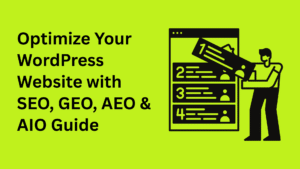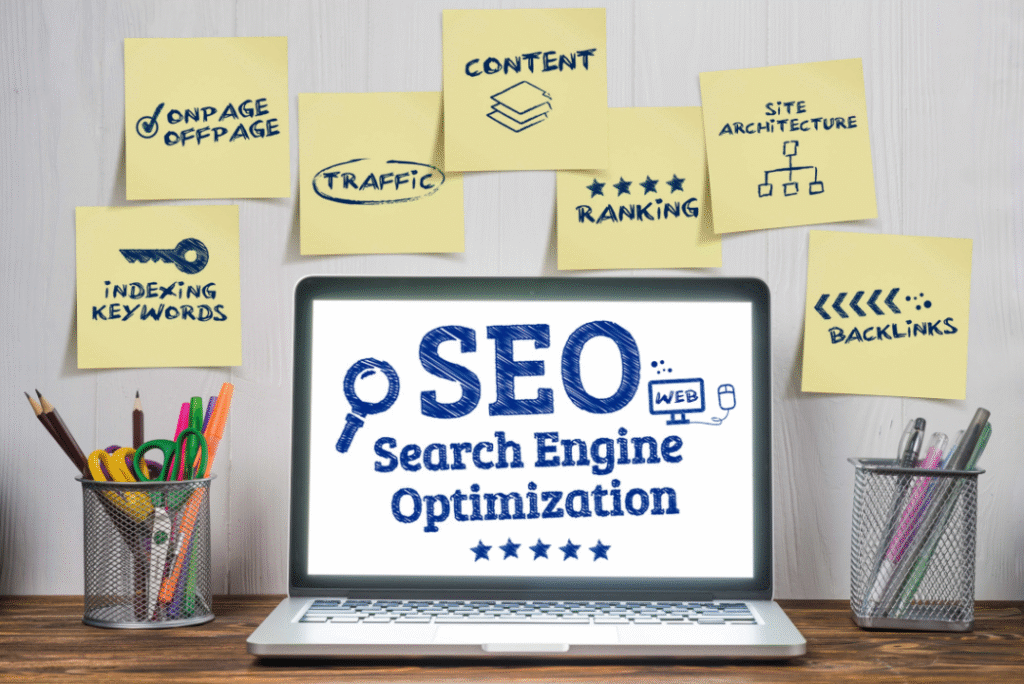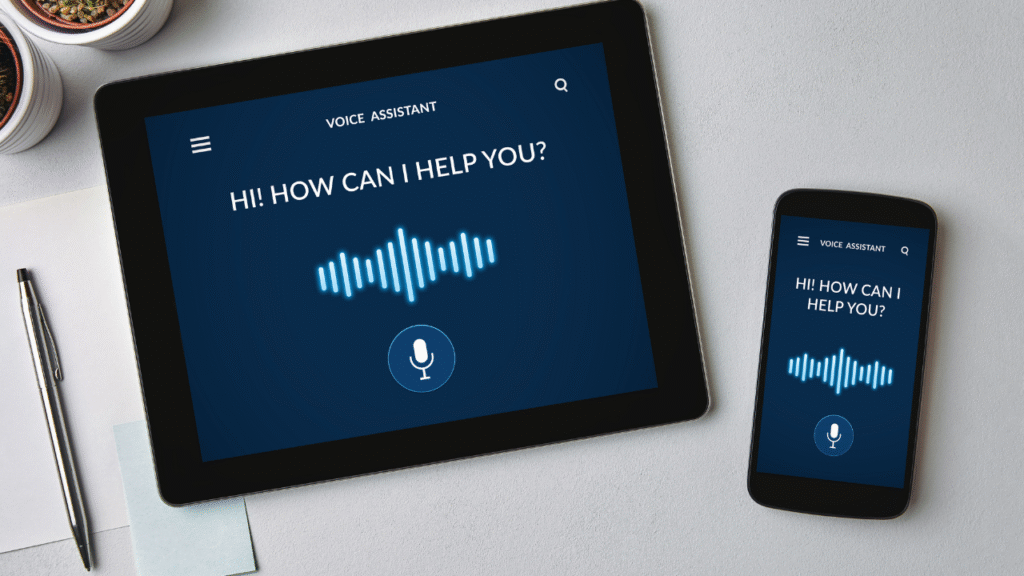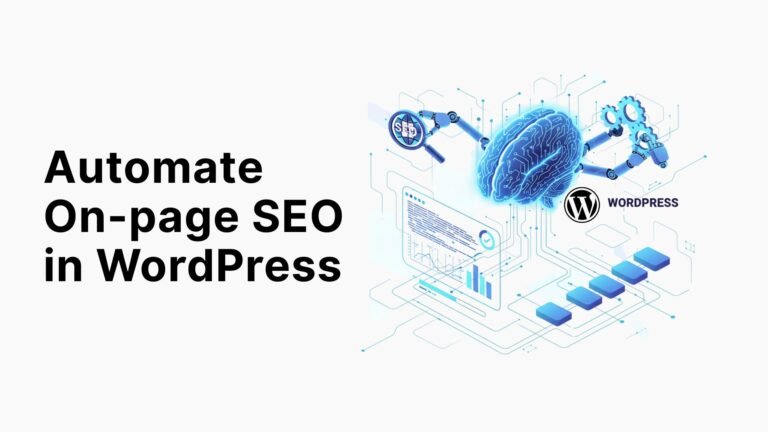A Platform for
Modern
WordPress Developers

The Ultimate SEO, GEO, AEO and AIO Guide for WordPress Sites in 2025
Introduction
If you are frustrated that your WordPress website is not ranking well in this digital landscape, then this Ultimate Guide on SEO, GEO, AEO, and AIO for WordPress websites is for you to overcome this problem.
In 2025, Search is no longer about just Google’s blue links. But people ask Siri, Alexa, and even ChatGPT to find what they need.
AI engines give you related and summarized answers instead of listing results like Google. That’s why AI searches are dominating everyday decisions.
Unless your WordPress site is optimized for this new reality, it risks being invisible.
That’s where the four pillars of modern digital optimization come in:
- SEO (Search Engine Optimization): still the foundation for ranking on Google, Bing, and other Search engines.
- GEO (Generative Engine Optimization): Optimizing content for AI search tools like Google AI Overviews, Bing Copilot, and ChatGPT so they can cite and feature your site in summaries.
- AEO (Answer Engine Optimization): Structuring content so voice assistants and answer engines (Siri, Alexa, Google Assistant) can deliver it as a direct response.
- AIO (AI Optimization): Making your site understandable and trustworthy for the wider AI ecosystem, from chatbots to recommendation engines.
By the end of this guide, you will not only understand what these terms mean, but you will also know how to optimize your WordPress site for them.
Understanding the 4 Pillars of Digital Optimization
Before we dive into the “how-to” steps, it’s important to understand the four pillars that now shape online visibility.
Think of them as the foundation of a modern digital house because without one, the whole structure feels incomplete.
Search Engine Optimization (SEO): The Backbone of Visibility
Search Engine Optimization (SEO) is still the king when it comes to being found online.
It’s the reason your site shows up on Google or Bing when someone types in a query.
Traditional SEO includes three parts:
- On-page SEO (optimizing your content, keywords, and structure)
- Off-page SEO (backlinks, social signals)
- Technical SEO (speed, security, mobile performance)
Even though search has evolved, SEO remains the backbone. If you ignore it, the other pillars will not stand strong.
Generative Engine Optimization (GEO): Getting Featured in AI Summaries
Generative Engine Optimization (GEO) is about preparing your content for AI-driven search tools like Google AI Overviews, Bing Copilot, or ChatGPT.
These engines do not just list links, but they summarize answers and often cite a few trusted sources.
GEO ensures your WordPress site is structured, clear, and authoritative enough to be referenced in those AI-generated responses.
Answer Engine Optimization (AEO): The Voice & AI Answer Strategy
Answer Engine Optimization (AEO) focuses on traffic from voice assistants and AI-driven answer engines.
When someone asks Alexa or Google Assistant a question, your content can either be the chosen answer or disappear entirely.
AEO ensures your website content becomes the direct answer by structuring the content in a clear, question-answer style with schema markup.
AI Optimization (AIO): Speaking the Language of AI Systems
AI Optimization (AIO) takes a broader approach than GEO or AEO.
Instead of focusing only on search engines or assistants, it ensures your site content can be understood and trusted across the wider AI ecosystem, from chatbots to AI recommendation systems.
It means writing content in natural, structured language, using metadata, and building authority so that any AI tool can confidently surface your site as reliable.
Together, these four pillars create a holistic strategy that keeps your WordPress site discoverable, both today and tomorrow.
Search Engine Optimization (SEO) for WordPress: Foundation of Ranking

When it comes to digital visibility, SEO is the foundation of everything else you do.
Think of it like preparing the soil before planting. If it is not healthy, nothing will grow.
For WordPress users, SEO is more accessible than ever thanks to plugins, built-in tools, and structured workflows.
Let’s break it down into three essential layers.
On-Page SEO: Getting the Basics Right
On-page SEO is what you directly control within your WordPress dashboard.
Start by installing a reliable SEO plugin such as RankMath, Yoast, or SEOPress. These tools guide you through optimizing titles, meta descriptions, and even readability.
Next, ensure your permalinks are short, clean, and keyword-rich (nobody wants to click on “/index.php?id=123”).
Schema markup is another game-changer; it tells search engines exactly what your content is (an article, product, recipe, review, etc.).
Finally, focus on internal linking, which connects your pages like a web, so both users and crawlers can easily navigate.
Technical SEO: The Engine Under the Hood
Even the best content won’t rank if your site loads slowly or feels clunky. That’s why technical SEO matters.
The speed of websites can be improved with caching plugins, CDNs (like Cloudflare), and image compression tools.
Pay attention to Google’s Core Web Vitals metrics like LCP (loading speed), CLS (visual stability), and FID (interactivity).
Your site should also be mobile-first and fully responsive, since the majority of searches now happen on phones.
And don’t forget security, where HTTPS is non-negotiable if you want trust and rankings.
Content SEO: The Heart of Growth
Content is the magnet that brings people to your site.
Use tools like SEMrush, Ubersuggest, or Ahrefs to find the right keywords, then organize them into pillar pages with supporting cluster articles.
Structure your posts with clear headings (H1, H2, H3) and make them engaging with images, videos, or infographics.
Great content doesn’t just rank, but it also builds authority and keeps people coming back.
Off-Page SEO: Building Authority Beyond Your Site
If on-page SEO makes your house attractive, off-page SEO is like your neighbors vouching for you. It’s about building credibility and trust across the web.
The most powerful factor here is backlinks (getting other reputable sites to link to yours).
Guest posting, collaborating with industry blogs, and earning mentions in online directories can all help.
Do not ignore social signals either, but active sharing on platforms like LinkedIn or Twitter gives you high reach and clicks and ultimately makes your content valuable.
In short, off-page SEO is your site’s reputation score, and it can make the difference between being buried on page 3 or shining on page 1
Master these four SEO layers, and you’ll have a rock-solid foundation to layer GEO, AEO, and AIO on top of.
Generative Engine Optimization (GEO) for WordPress: Be Visible in AI Summaries

Not every WordPress site needs GEO (Generative Engine Optimization), but if your content relies on visibility in AI-driven search results like blogs, SaaS, agencies, or ecommerce, then this pillar is non-negotiable.
In 2025, people don’t just click blue links; instead, they read AI overviews, summaries, and conversational answers.
Whether someone asks Google AI for “best WordPress SEO plugins” or Bing Copilot for “how to start a fitness blog,” generative engines decide whose content gets quoted.
Here’s how you can win those spots.
Structured Content: Feed the Engines Correctly
AI engines love clean and structured writing.
Use clear headings, bullet points, FAQs, and schema markup to make your WordPress posts machine-readable.
Plugins like Rank Math or Yoast can help you implement FAQ, How-To, and Article schema easily.
Context-Rich Writing: Go Beyond Keywords
Generative engines don’t just look for keywords, but they look for context and depth.
Instead of writing “best hosting providers,” include comparisons, pros/cons, and scenarios.
The richer your content, the higher the chance AI will pull it into summaries.
Source Credibility: Earn Trust Signals
AI tools prioritize authoritative sources.
Build credibility by linking to research, citing trusted references, and earning backlinks.
Display author bios and expertise on your WordPress site with the EEAT Technique (Experience, Expertise, Authoritativeness, Trustworthiness), which directly influences which sites AI recommends.
Conversational Optimization: Match the Questions
People talk to AI tools like they talk to humans.
Anticipate questions and answer them naturally in your content.
Create short, direct sections like “What is WordPress hosting?” followed by a clear and short answer before giving details.
Content Refresh: Stay in the AI Feed For a Long Time
Unlike static SEO, GEO demands freshness. AI engines prefer up-to-date information.
Keep your articles updated regularly, add new examples, and expand FAQs as search behaviors evolve.
Master GEO, and your content won’t just appear in Google search results, but it will be quoted, summarized, and recommended inside the AI overviews that most users now read first.
Answer Engine Optimization (AEO) for WordPress: Become the Answer in the AI Era

If SEO makes you visible on Google, then AEO (Answer Engine Optimization) makes your website content as the chosen answer in AI Engines.
In 2025, people do not just type queries, but they ask Siri, Alexa, or even ChatGPT for help.
The difference? Instead of scrolling through links, users often get one single spoken or AI-generated answer.
If your WordPress site is not optimized for this shift, you risk being left out of the conversation entirely.
Voice Search Readiness: Speak Their Language
People talk to devices differently from how they type.
Instead of “weather Paris,” they’ll ask, “What’s the weather like in Paris today?” That’s why conversational long-tail keywords are critical.
Anticipate how real people ask questions, then build content around those queries. Add FAQ sections to your site and mark them with structured data so voice assistants can easily pick them up.
Featured Snippets & “People Also Ask”: Winning Position Zero
Answer engines love concise, structured information.
That’s why the most valuable real estate on Google is Position Zero, which is the “featured snippet box”.
Aim for it by writing clear definitions, bullet lists, or step-by-step tables. For example, if you’re explaining “How to install a WordPress plugin,” a simple numbered list can get you featured.
Conversational Content: Write Like You Talk
AEO rewards content that sounds natural. Think of your blog as a conversation with your audience.
Ask the questions they would ask, then answer them directly. This not only helps with AI assistants but also engages human readers.
Schema Markup for AEO: Helping Machines Understand
Structured data is the bridge between your content and answer engines.
Implement FAQ schema, How-to schema, and Article schema to guide Google, Bing AI, and other assistants.
WordPress plugins like Yoast SEO or RankMath make this process straightforward.
By embracing AEO, your WordPress site won’t just be found, but it will be heard and quoted by the many engines shaping the future of search.
AI Optimization (AIO) for WordPress: Optimizing for the AI-First Web

We are entering a world where search is no longer just about Google, but it’s about AI-driven platforms that summarize, recommend, and even replace traditional search results.
This is where AIO (AI Optimization) comes in.
If SEO is about ranking, and AEO is about being the answer, then AIO is about making sure AI understands, trusts, and cites your content.
AI-Friendly Content: Speak the AI Language
AI engines rely heavily on context. That means your content needs to be semantic, clear, and structured.
Use semantic keywords (also called LSI terms, which means the use of related words and phrases that show depth.
For example, instead of repeating “WordPress SEO” a hundred times, include related concepts like “schema,” “plugins,” “core web vitals,” and “content clusters.”
Organize content with clear headers (H1, H2, H3) so AI can scan it easily, and keep sentences straightforward for readability.
Optimizing for AI Chatbots: Rank Beyond Google Search
Search is no longer limited to browsers. People ask ChatGPT, Gemini, Perplexity, and Bing AI for recommendations.
To get quoted by these tools, write content in a way that’s direct, factual, and easy to pull as a snippet.
For example, a concise definition, a numbered list, or a short explainer paragraph is more likely to be used by an AI system.
AI-Powered Tools: Your AI Optimization Partners
Instead of guessing what AI wants, use tools built for it.
Surfer SEO helps with NLP (natural language processing) optimization, NeuronWriter strengthens semantic coverage, and Frase/MarketMuse analyzes topic gaps so your content fully answers queries.
These tools ensure your WordPress content aligns with how AI evaluates authority.
Future-Proofing: Playing the Long Game
AI search is powerful, but unpredictable. Do not rely on a single traffic source.
Blend human-written and AI-assisted content, maintain E-E-A-T (Experience, Expertise, Authority, Trust), and focus on credibility.
That way, whether it’s Google or the next big AI assistant, your WordPress site stays visible.
AIO isn’t just a trend, but it’s the safeguard that keeps your site relevant in an AI-first future.
Integrating SEO, GEO, AEO & AIO Together
By now, you have understood each pillar (SEO, GEO, AEO, and AIO). But here’s the real magic: they don’t work in isolation.
The most powerful WordPress strategies combine all four into one unified content approach.
Think of it like cooking a perfect dish.
SEO is your base ingredient, GEO makes your content visible in AI-driven search overviews, AEO makes it digestible for voice and answer engines, and AIO ensures it’s future-ready for AI-first discovery.
When you mix them right, you do not just appear in search results, but you will appear everywhere people are searching, asking, and exploring.
A Practical Example of Coffee Shops in Lahore
Imagine you’re writing a blog post titled: “Best Coffee Shops in New York City 2025.”
- SEO: You target the keyword “best coffee shops New York City” and optimize the title, headings, and meta description.
- GEO: You structure content so AI Overviews and tools like Bing Copilot or Perplexity can summarize it by using clear sections, cited sources, and fact-rich content that engines can pull directly into their generative answers.
- AEO: You include an FAQ section with conversational questions like “Where can I find coffee near me?” and provide direct, concise answers that can rank for featured snippets or voice searches.
- AIO: You enrich the post with semantic depth like discussing “coffee culture,” “third-wave cafés,” and “specialty brews,” so AI models will view it as authoritative and recommend it in broader discussions about coffee experiences.
Not every piece of content needs all four pillars, but the goal is to strategically layer them.
A global SaaS company may focus more on SEO + AIO, while a lifestyle blog benefits from GEO + AEO.
The sweet spot is to find the right mix between ranking, being cited in AI summaries, and showing up in conversational answers.
When integrated, these four pillars turn your WordPress site into a future-proof digital asset that ranks, answers, and gets recommended across every platform, whether it is traditional search, AI assistants, or generative summaries.
Tools & Plugins for WordPress Optimization
Having the right strategy is step one, and step two is equipping yourself with the right tools.
WordPress makes this easier with powerful plugins and third-party helpers that simplify SEO, GEO, AEO, and AIO implementation.
SEO Plugins
These are the backbone of optimization, helping with meta tags, sitemaps, and on-page improvements:
- Rank Math – Lightweight, feature-rich, and integrates deeply with schema and AI tools.
- Yoast SEO – The classic plugin, great for beginners with real-time readability and SEO checks.
- SEOPress – Affordable and privacy-friendly, perfect for agencies managing multiple sites.
GEO Plugins
Generative engines (Google AI Overviews, Bing Copilot, Perplexity, etc.) demand content structured for AI-driven summaries.
These helpers prepare your content to be surfaced in AI-generated answers:
- Surfer SEO – Optimizes semantic keywords and topical authority for AI-generated overviews.
- Frase – Ensures comprehensive coverage of topics that AI models prefer when curating answers.
- Neuron Writer – Focuses on semantic relevance, intent matching, and knowledge graph alignment.
AEO Tools (Answer Engine Optimization)
Voice and AI assistants love structured, concise answers. These tools help you get there:
- Google’s Structured Data Markup Helper – Build clean schema markup for FAQs, businesses, and how-to content.
- FAQ Block Plugins (e.g., Ultimate Blocks, Yoast FAQ block) – Create SEO-friendly FAQ sections that search engines and voice assistants can read easily.
AIO Helpers (AI Optimization)
With AI-driven search growing fast, you will want tools that align content with how AI understands language:
- Originality.ai or GPTZero – Detect AI-generated content and maintain authenticity and avoid over-reliance on AI-written text.
- MarketMuse – Helps build topical depth and authority for long-term AI visibility.
- ClearScope – Analyzes semantic relevance for AI-driven engines and user-friendly readability.
Together, these plugins and tools give you a practical stack to cover every pillar of optimization without overcomplicating your workflow.
Common Mistakes & How to Fix Them
Even with the right tools, many site owners trip over common pitfalls that weaken their SEO, GEO, AEO, and AIO strategy. Here’s what to watch out for and how to fix them:
Over-Optimizing with Keyword Stuffing
The mistake: Jamming the same keyword into every sentence (e.g., “best coffee shop in London” repeated 15 times).
This makes the content unreadable and can trigger Google penalties.
Fix it: Use keywords naturally. Mix in semantic variations (synonyms, related terms) and focus on answering intent, not repeating phrases.
Forgetting Structured Data for AEO
The mistake: Writing content but not marking it up with schema, so search engines and answer engines cannot understand, interpret, or feature it properly.
Fix it: Add JSON-LD schema (via Schema Pro or Rank Math) for FAQs, articles, events, and local businesses. Structured data gives you a higher chance of appearing in rich snippets, voice search results, and AI answers.
Relying Only on AI Content → Lacks Trustworthiness
The mistake: Publishing raw AI-generated articles without edits. AI can create generic or even inaccurate content, which reduces trust and may hurt rankings.
Fix it: Use AI as a helper, not a replacement. Always fact-check, edit, and add original insights, data, or experiences to keep content authentic and reliable.
Conclusion & Next Steps
In 2025, succeeding with WordPress is not about choosing between SEO, GEO, AEO, or AIO, but it’s about bringing them all together.
Think of it as a four-pillar strategy:
- SEO → the foundation that ensures your site ranks in search.
- GEO → optimization for generative engines (AI overviews, Perplexity, Copilot) so your content gets cited in AI-driven answers.
- AEO → the answer-driven approach that wins voice searches and rich snippets.
- AIO → the AI-ready optimization that future-proofs your content for credibility, accuracy, and adaptability.
By combining these, you are not just optimizing for Google but for search engines, AI engines, and human discovery all at once.
The Future Outlook
Search is rapidly evolving toward AI-first results.
Tools like ChatGPT, Perplexity, and Google Gemini are already changing how people find information.
In the coming years, sites that prepare with structured data, AI-friendly content, and generative engine optimization will stay miles ahead of the competition.
Your Next Steps
- Start with SEO basics: site speed, on-page optimization, and quality content.
- Layer in GEO: design content so it gets picked up and cited by AI overviews and generative search.
- Add AEO: FAQs, structured data, and direct answers.
- Future-proof with AIO: semantic depth, fact-checking, and human insights that AI can trust.
Remember, this is not a one-time task but an ongoing process of refinement.
Ready to take your WordPress site to the next level? 🚀
👉 Start applying the strategies today, and do not forget to subscribe to our newsletter for more in-depth guides, case studies, and future-focused SEO and WordPress knowledge.
